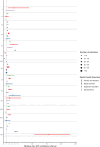Comorbid physical health burden of serious mental health disorders in 32 European countries
- PMID: 38580438
- PMCID: PMC11021748
- DOI: 10.1136/bmjment-2024-301021
Comorbid physical health burden of serious mental health disorders in 32 European countries
Abstract
Background: Mental health disorders (MHDs) are associated with physical health disparities, but underlying excess risk and health burden have not yet been comprehensively assessed.
Objective: To assess the burden of comorbid physical health conditions (PHCs) across serious MHDs in Europe.
Methods: We estimated the relative prevalence risk of PHCs associated with alcohol use disorders (AUD), bipolar disorder (BD), depressive disorders (DD) and schizophrenia (SZ) across working-age populations of 32 European countries in 2019 based on a targeted literature review. Excess physical health burden was modelled using population-attributable fractions and country-level prevalence data.
Findings: We screened 10 960 studies, of which 41 were deemed eligible, with a total sample size of over 18 million persons. Relative prevalence of PHCs was reported in 54%, 20%, 15%, 5% and 7% of studies, respectively, for SZ, DD, BD, AUD or mixed. Significant relative risk estimates ranged from 1.44 to 3.66 for BD, from 1.43 to 2.21 for DD, from 0.81 to 1.97 for SZ and 3.31 for AUD. Excess physical health burden ranged between 27% and 67% of the total, corresponding to 84 million (AUD), 67 million (BD), 66 million (DD) and 5 million (SZ) PHC diagnoses in Europe. A 1% reduction in excess risk assuming causal inference could result in two million fewer PHCs across investigated MHDs.
Conclusions: This is the first comprehensive study of the physical health burden of serious MHDs in Europe. The methods allow for updates, refinement and extension to other MHDs or geographical areas.
Clinical implications: The results indicate potential population health benefits achievable through more integrated mental and physical healthcare and prevention approaches.
Keywords: Adult psychiatry; Data Interpretation, Statistical; Depression & mood disorders; Schizophrenia & psychotic disorders; Substance misuse.
© Author(s) (or their employer(s)) 2024. Re-use permitted under CC BY-NC. Published by BMJ.
Conflict of interest statement
Competing interests: CA has been a consultant to or has received honoraria or grants from Acadia, Angelini, Biogen, Boehringer, Gedeon Richter, Janssen Cilag, Lundbeck, Medscape, Menarini, Minerva, Otsuka, Pfizer, Roche, Sage, Servier, Shire, Schering-Plough, Sumitomo Dainippon Pharma, Sunovion and Takeda. GMK has received honoraria as a speaker or consultant for Angelini, Gilgamesh, H Lundbeck, Onsero, Pangea, Sage and Sanos. GMG is Chief Medical Officer at Compass Pathways, holds shares and share options at Compass Pathways, and has served as consultant, advisor or CME speaker in the last 3 years for Beckley Psytech, Boehringer Ingelheim, Clerkenwell Health, Compass Pathways, Evapharma, Janssen, Lundbeck, Medscape, Novartis, Ocean Neuroscience, P1Vital, Servier and Takeda. JS has received honoraria as academic advisor from the European Brain Council.
Figures



References
-
- Correll CU, Solmi M, Veronese N, et al. . Prevalence, incidence and mortality from cardiovascular disease in patients with pooled and specific severe mental illness: a Large‐Scale Meta‐Analysis of 3,211,768 patients and 113,383,368 controls. World Psychiatry 2017;16:163–80. 10.1002/wps.20420 - DOI - PMC - PubMed
